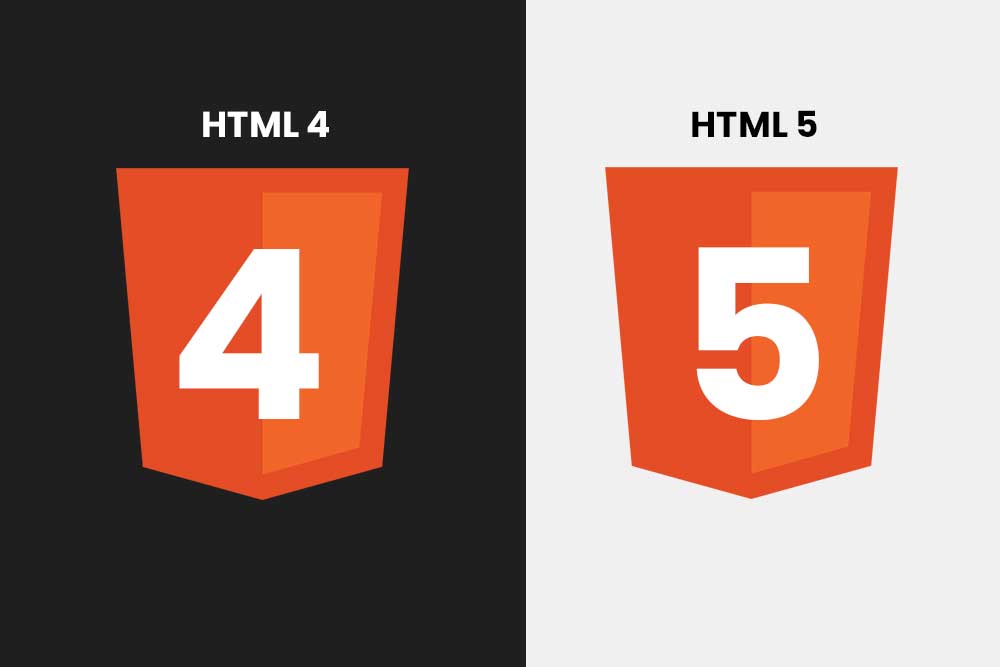HTML is not a programming language. It is a markup language, and it is one of the most important components of web development. HTML 4 was published in 1997 while HTML 5 was published in 2014. The latest version of HTML, HTML5 has many new features while HTML4 had less features.
The differences between these two are the following:
- HTML4 does not have any form validation or editing capabilities so cannot be used to enter data into forms on web pages.
- It also lacks some elements required for modern web development such as, , and tags that are present in the latest version,< html5>.
- HTML4 does not have any form validation or editing capabilities so cannot be used to enter data into forms on web. but HTML 4 is the successor of HTML 3.2, the “World Wide Web”. It is an old version of HTML webpages and has many disadvantages when compared to its more advanced counterpart – HTML5.
What are the new tags of html 5?
HTML 5 is the latest version of HTML and enables people to create interactive content. There are three new tags: audio, video, and canvas.
The new tags in HTML5 can be used to create rich media contents that are interactive.
Some of the new features in HTML5 are:
- HTML5 canvas – allows developers to dynamically create images, animations, and even video.
- Web storage – provides similar functionality to cookies but without the limitations of browser space.
- Drag and drop – enables easier interactions with user interfaces using a mouse.
- Web workers – enable long running tasks without blocking the interface from other users.
- Geo-location API – provides information about your location based on your IP address, such as latitude and longitude coordinates, altitude, heading, speed and accuracy.
Differences is the User Geographical location.
The User Geographical location has changed in HTML 5. In HTML 4, it was always necessary to specify the country code to identify the geographical location of a user. This is not necessary in HTML 5 because it uses IP address to determine the user’s geographical location, which is more accurate than using the country code.
Client Side storage difference between html 4 and html 5
The HTML 4 storage model is a client-side-persistent storage model.
The HTML 5 storage model is a client-side-session storage model.
In the HTML 4 storage model, when a user navigates from one page to another, the browser stores the data from the previous page in order to provide it with a seamless experience. In this case, when a user navigates back to the previous page, all of its data will be restored and be available for use with no negative effects.
In contrast, in the HTML 5 storage model, when a user navigates from one page to another, all data associated with that session is lost and only restored when they return back to that specific website.
Improved Element Semantics in html 5
The improved semantics in HTML5 can be utilized by developers to build better web pages with meaningful content that is more search engine friendly.
The new semantics in html 5 has been designed to help developers by their definition and provide more information on the page. HTML4 had some semantics, but they were not specific enough to give a developer all the needed information on what they were coding. The new element semantics in html5 will offer more than just a visual cue. They will also specify what data type is being used and if the element has any special functionality.
The Improved Element Semantics in html 5 means that we can now:
- Add: “type”, “id”, “itemprop” and “itemscope” to an element if we want it to have those properties;
- Specify whether an element is interactive or not; etc.
Character Encoding in html 5
HTML5 is the latest and most up to date version of HTML. It is style-sheet-based and allows for easier internationalization, making it superior to its predecessor.
The encoding of a character is how it will be represented in your document. All characters can be encoded as either ASCII or UTF-8.
ASCII was the original encoding that web browsers used for web pages. Nowadays, most browsers support UTF-8 encoding as well as ASCII encoding, but some browsers still use ASCII encoding only and do not support UTF-8.
MathML and SVG
HTML5 is the latest version of the HTML standard. It has many features that HTML 4 does not have, including MathML and SVG.
MathML and SVG allow for much richer typesetting than was possible in earlier versions of HTML, by adding support for mathematics and vector graphics respectively.
Many web browsers also now support these two languages natively, so they do not need to be turned off in order to see the content on a page.
With the advent of html 5, there are two new tags that have been introduced to provide support for math and vector graphics.
The MathML tag is a markup language for mathematical expressions. The SVG tag is a markup language for vector graphics. SVG images can be animated, enabling the creation of dynamic graphical representations of objects in motion. They are now supported by all major web browsers and mobile device platforms, including Apple’s latest operating systems iOS 11 and macOS High Sierra.
Both MathML and SVG have been standardized by W3C as HTML5 tags, which means that they are now part of the html 5 specification.
Mobile support in html 5 and html 4
Mobile support in html 5 and html 4 comes in the form of different web designs. It is not just about mobile-friendly websites, but mobile-friendly apps as well. Google has made it easy for developers to create mobile apps with their tools.
Mobile support in html 5 and html 4 is a set of best practices that are used to provide an experience that is optimized for both desktops and mobiles while at the same time, meeting compliance guidelines.
The latest technology trends are moving towards the use of HTML5 because it provides better responsive design, faster loading time, better speed, less memory use among others. This makes it easier to develop websites with high quality content through reducing development expenses.




